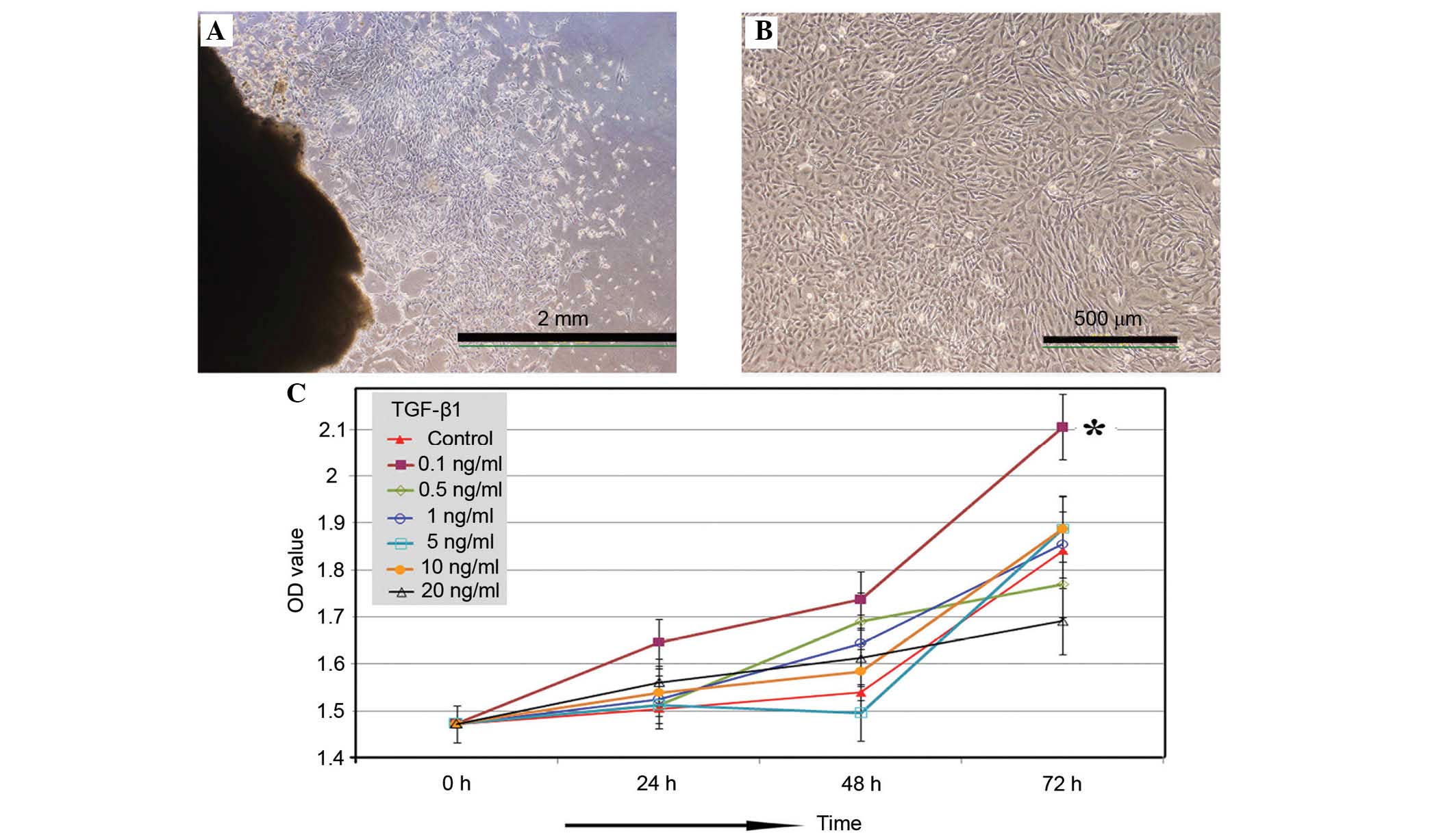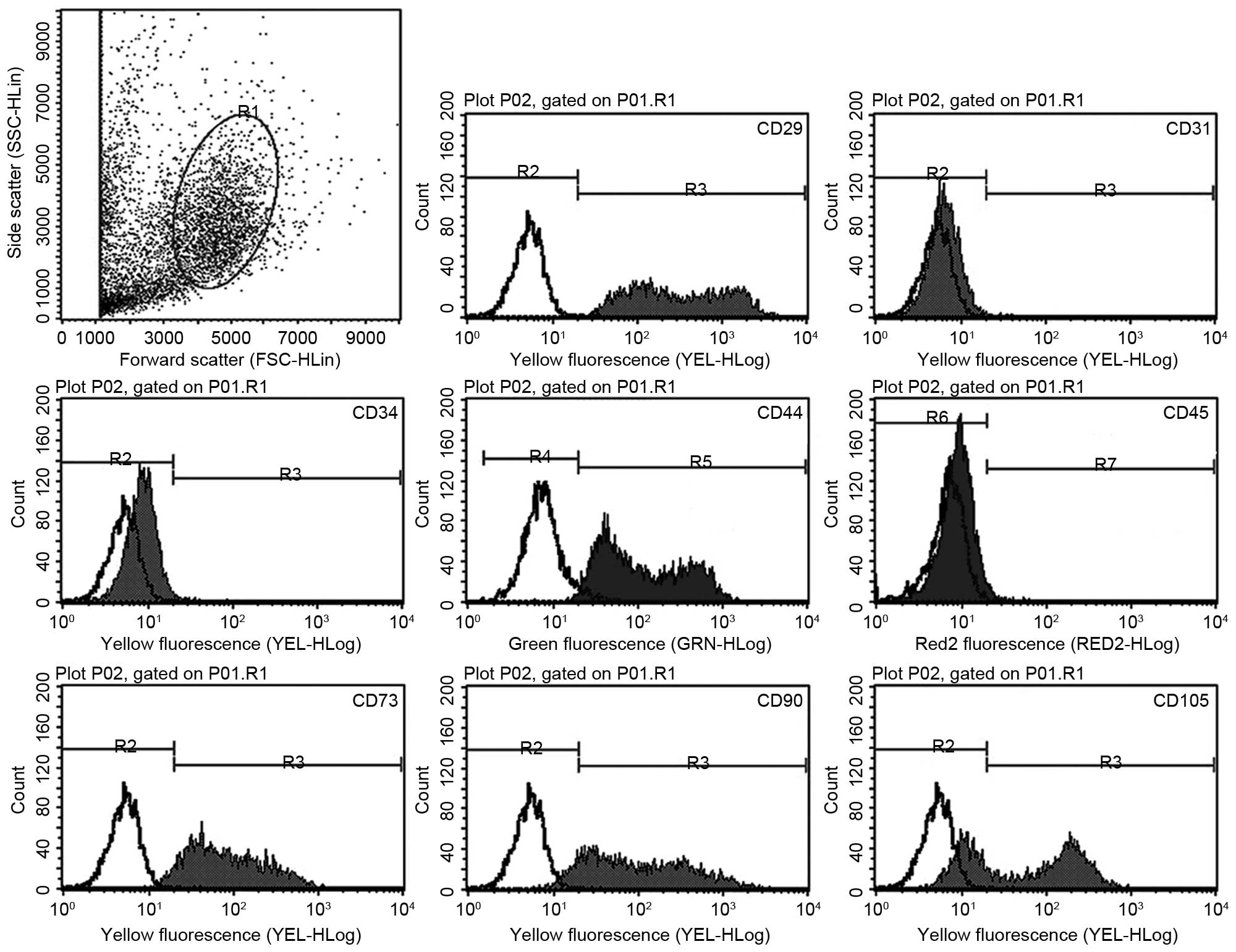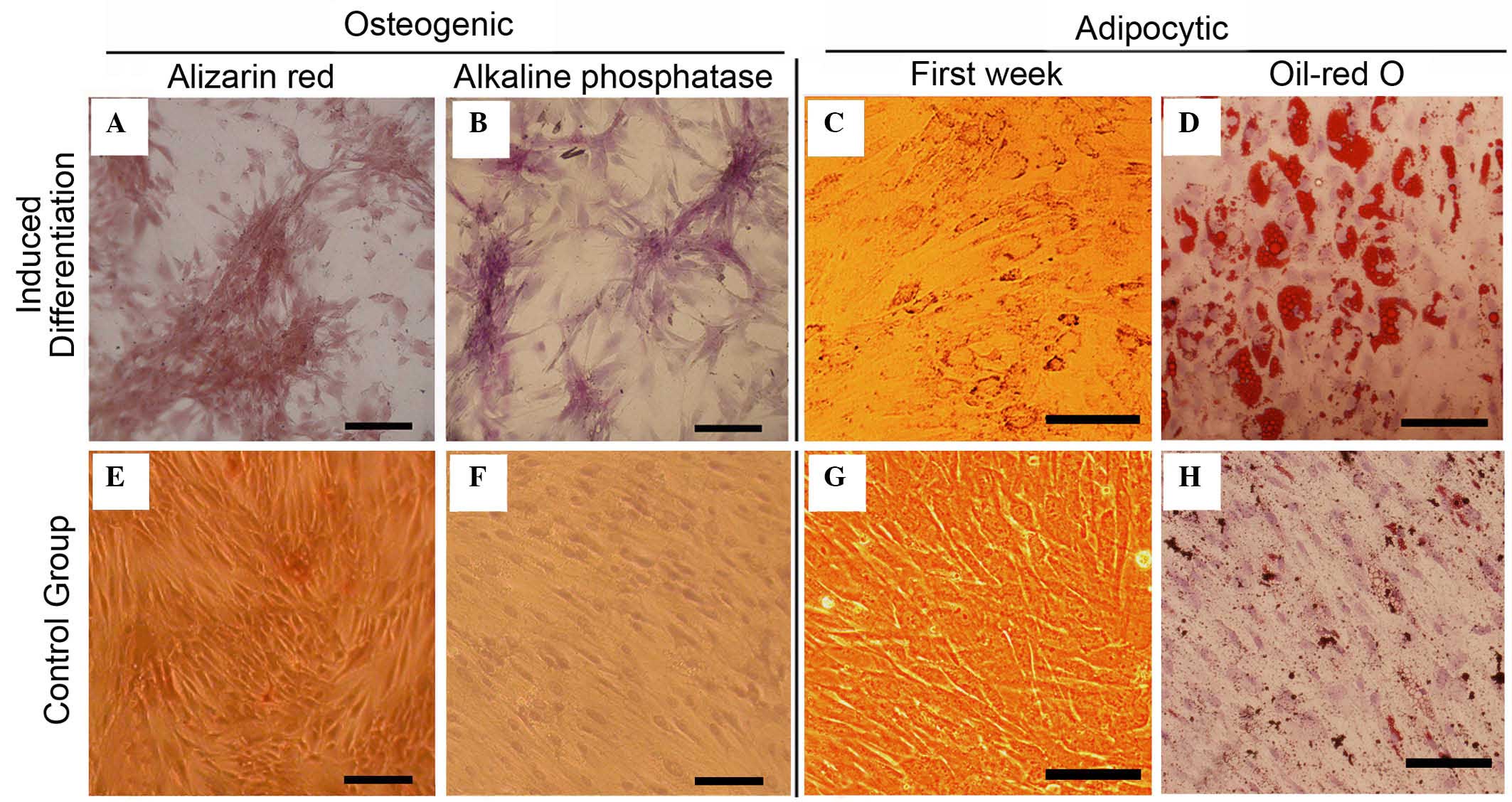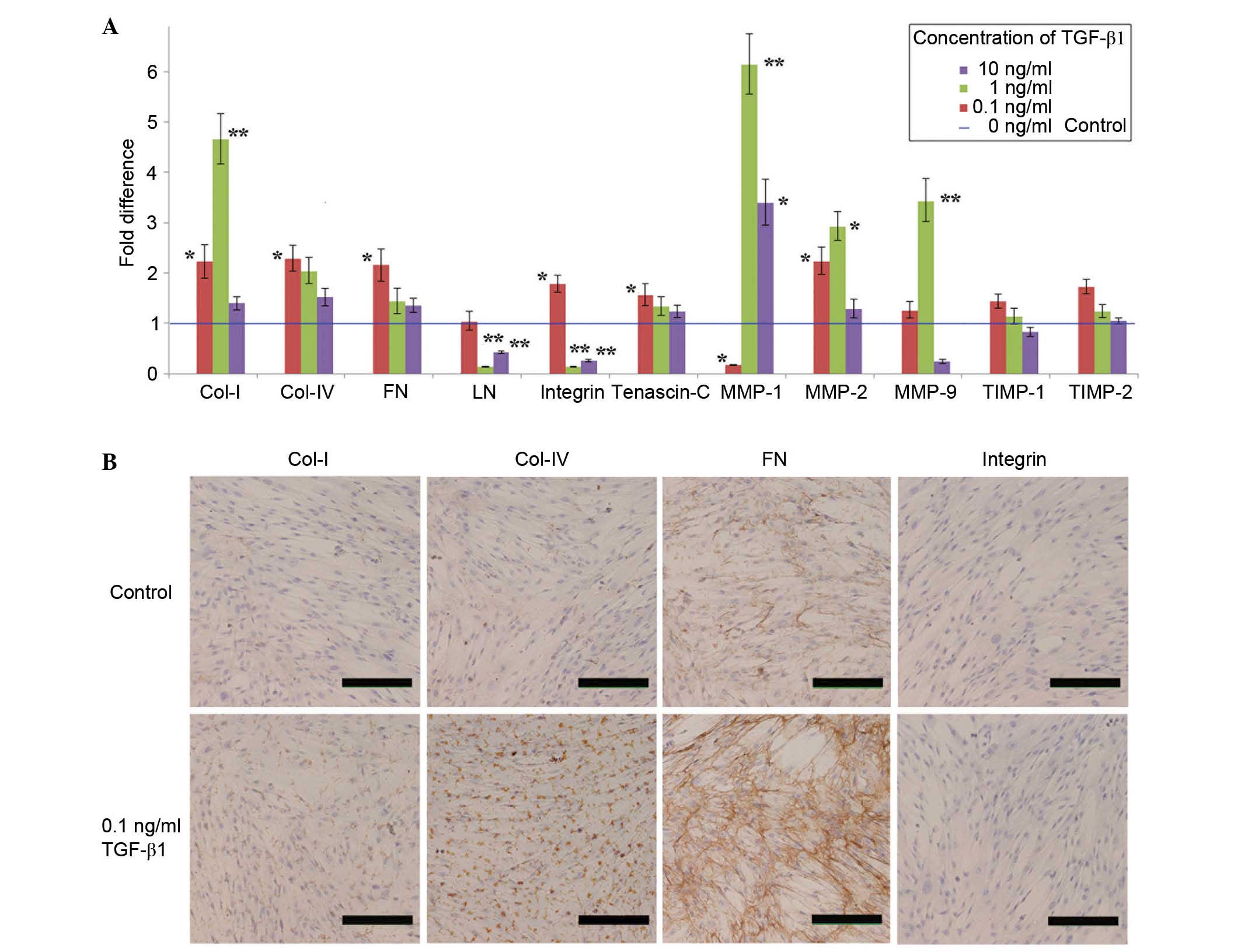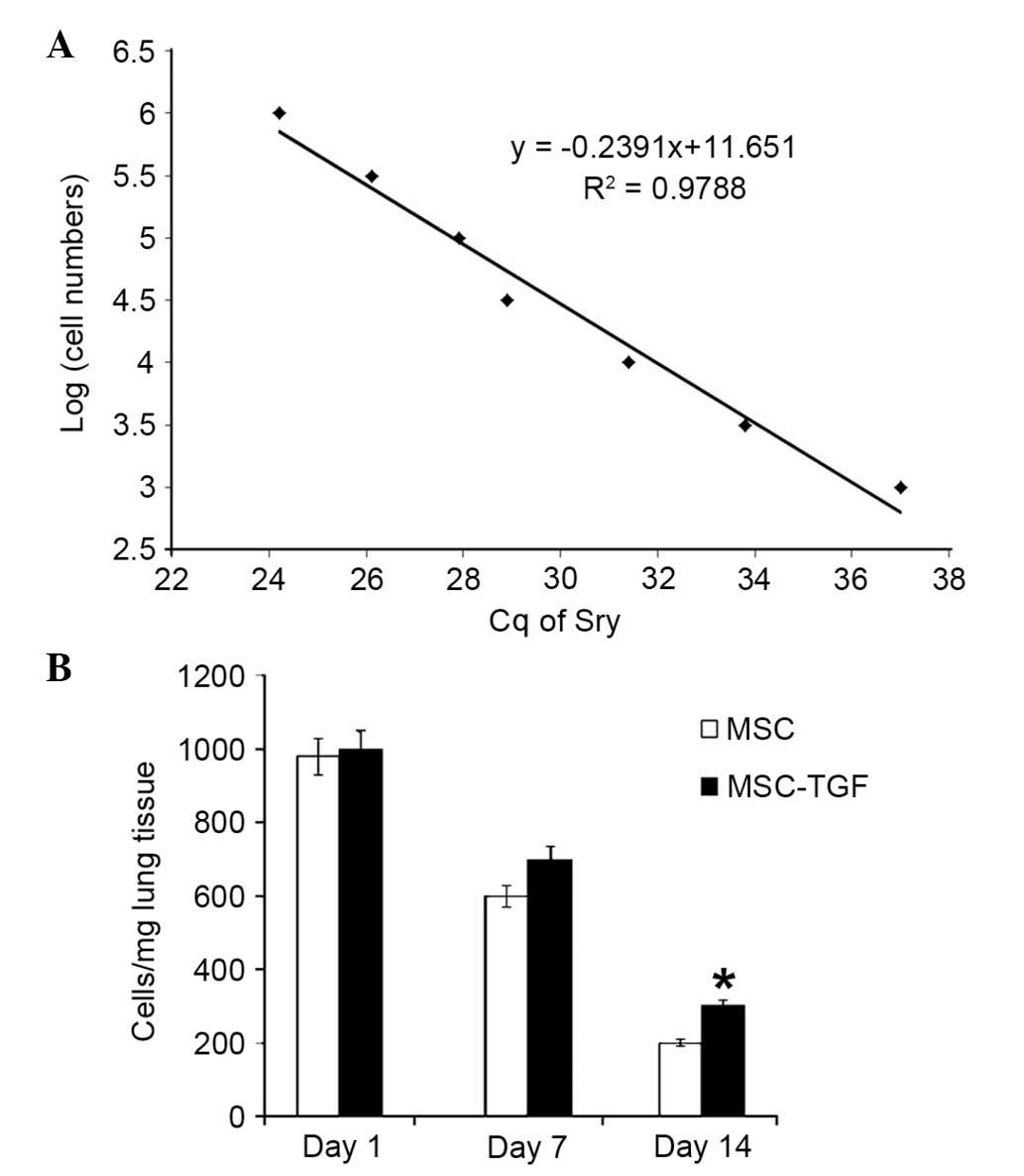|
1
|
Pittenger MF and Martin BJ: Mesenchymal
stem cells and their potential as cardiac therapeutics. Cir Res.
95:9–20. 2004. View Article : Google Scholar
|
|
2
|
Wu KH, Tsai C, Wu HP, Sieber M, Peng CT
and Chao YH: Human application of ex vivo expanded umbilical
cord-derived mesenchymal stem cells: Enhance hematopoiesis after
cord blood transplantation. Cell Transplant. 22:2041–2051. 2013.
View Article : Google Scholar : PubMed/NCBI
|
|
3
|
Le Blanc K, Rasmusson I, Sundberg B,
Götherström C, Hassan M, Uzunel M and Ringdén O: Treatment of
severe acute graft-versus-host disease with third party
haploidentical mesenchymal stem cells. Lancet. 363:1439–1441. 2004.
View Article : Google Scholar : PubMed/NCBI
|
|
4
|
Sudres M, Norol F, Trenado A, Grégoire S,
Charlotte F, Levacher B, Lataillade JJ, Bourin P, Holy X, Vernant
JP, et al: Bone marrow mesenchymal stem cells suppress lymphocyte
proliferation in vitro but fail to prevent graft-versus-host
disease in mice. J Immunol. 176:7761–7767. 2006. View Article : Google Scholar : PubMed/NCBI
|
|
5
|
Marion NW and Mao JJ: Mesenchymal stem
cells and tissue engineering. Methods Enzymol. 420:339–361. 2006.
View Article : Google Scholar : PubMed/NCBI
|
|
6
|
Shi S, Bartold PM, Miura M, Seo BM, Robey
PG and Gronthos S: The efficacy of mesenchymal stem cells to
regenerate and repair dental structures. Orthod Craniofac Res.
8:191–199. 2005. View Article : Google Scholar : PubMed/NCBI
|
|
7
|
Fiedler J, Etzel N and Brenner RE: To go
or not to go: Migration of human mesenchymal progenitor cells
stimulated by isoforms of PDGF. J Cell Biochem. 93:990–998. 2004.
View Article : Google Scholar : PubMed/NCBI
|
|
8
|
Gao J and Caplan AI: Mesenchymal stem
cells and tissue engineering for orthopaedic surgery. Chir Organi
Mov. 88:305–316. 2003.In English, Italian.
|
|
9
|
Tuan RS, Boland G and Tuli R: Adult
mesenchymal stem cells and cell-based tissue engineering. Arthritis
Res Ther. 5:32–45. 2003. View
Article : Google Scholar : PubMed/NCBI
|
|
10
|
Hsiao ST, Asgari A, Lokmic Z, Sinclair R,
Dusting GJ, Lim SY and Dilley RJ: Comparative analysis of paracrine
factor expression in human adult mesenchymal stem cells derived
from bone marrow, adipose, and dermal tissue. Stem Cells Dev.
21:2189–2203. 2012. View Article : Google Scholar :
|
|
11
|
Lu LL, Liu YJ, Yang SG, Zhao QJ, Wang X,
Gong W, Han ZB, Xu ZS, Lu YX, Liu D, et al: Isolation and
characterization of human umbilical cord mesenchymal stem cells
with hematopoiesis-supportive function and other potentials.
Haematologica. 91:1017–1026. 2006.PubMed/NCBI
|
|
12
|
Liu S, Yuan M, Hou K, Zhang L, Zheng X,
Zhao B, Sui X, Xu W, Lu S and Guo Q: Immune characterization of
mesenchymal stem cells in human umbilical cord Wharton's jelly and
derived cartilage cells. Cell Immunol. 278:35–44. 2012. View Article : Google Scholar : PubMed/NCBI
|
|
13
|
Peng J, Wang Y, Zhang L, Zhao B, Zhao Z,
Chen J, Guo Q, Liu S, Sui X, Xu W and Lu S: Human umbilical cord
Wharton's jelly-derived mesenchymal stem cells differentiate into a
Schwann-cell phenotype and promote neurite outgrowth in vitro.
Brain Res Bull. 84:235–243. 2011. View Article : Google Scholar : PubMed/NCBI
|
|
14
|
Tamama K, Kawasaki H and Wells A:
Epidermal growth factor (EGF) treatment on multipotential stromal
cells (MSCs). Possible enhancement of therapeutic potential of MSC.
J Biomed Biotechnol. 2010:7953852010. View Article : Google Scholar : PubMed/NCBI
|
|
15
|
Freyman T, Polin G, Osman H, Crary J, Lu
M, Cheng L, Palasis M and Wilensky RL: A quantitative, randomized
study evaluating three methods of mesenchymal stem cell delivery
following myocardial infarction. Eur Heart J. 27:1114–1122. 2006.
View Article : Google Scholar : PubMed/NCBI
|
|
16
|
Song H, Song BW, Cha MJ, Choi IG and Hwang
KC: Modification of mesenchymal stem cells for cardiac
regeneration. Expert Opin Biol Ther. 10:309–319. 2010. View Article : Google Scholar : PubMed/NCBI
|
|
17
|
Thibault MM, Hoemann CD and Buschmann MD:
Fibronectin, vitronectin, and collagen I induce chemotaxis and
haptotaxis of human and rabbit mesenchymal stem cells in a
standardized transmembrane assay. Stem Cells Dev. 16:489–502. 2007.
View Article : Google Scholar : PubMed/NCBI
|
|
18
|
Basile DP, Martin DR and Hammerman MR:
Extracellular matrix-related genes in kidney after ischemic injury:
Potential role for TGF-beta in repair. Am J Physiol. 275:F894–F903.
1998.PubMed/NCBI
|
|
19
|
Lee JH, Yu HS, Lee GS, Ji A, Hyun JK and
Kim HW: Collagen gel three-dimensional matrices combined with
adhesive proteins stimulate neuronal differentiation of mesenchymal
stem cells. J R Soc Interface. 8:998–1010. 2011. View Article : Google Scholar : PubMed/NCBI
|
|
20
|
O'Callaghan CJ and Williams B: Mechanical
strain-induced extracellular matrix production by human vascular
smooth muscle cells: Role of TGF-beta(1). Hypertension. 36:319–324.
2000. View Article : Google Scholar : PubMed/NCBI
|
|
21
|
Lee YC and Rannels DE: Regulation of
extracellular matrix synthesis by TNF-alpha and TGF-beta1 in type
II cells exposed to coal dust. Am J Physiol. 275:L637–L644.
1998.PubMed/NCBI
|
|
22
|
Baarsma HA, Menzen MH, Halayko AJ, Meurs
H, Kerstjens HA and Gosens R: β-Catenin signaling is required for
TGF-β1-induced extracellular matrix production by airway smooth
muscle cells. Am J Physiol Lung Cell Mol Physiol. 301:L956–L965.
2011. View Article : Google Scholar : PubMed/NCBI
|
|
23
|
Ng F, Boucher S, Koh S, Sastry KS, Chase
L, Lakshmipathy U, Choong C, Yang Z, Vemuri MC, Rao MS and Tanavde
V: PDGF, TGF-beta, and FGF signaling is important for
differentiation and growth of mesenchymal stem cells (MSCs):
Transcriptional profiling can identify markers and signaling
pathways important in differentiation of MSCs into adipogenic,
chondrogenic, and osteogenic lineages. Blood. 112:295–307. 2008.
View Article : Google Scholar : PubMed/NCBI
|
|
24
|
Jian H, Shen X, Liu I, Semenov M, He X and
Wang XF: Smad3-dependent nuclear translocation of beta-catenin is
required for TGF-beta1-induced proliferation of bone marrow-derived
adult human mesenchymal stem cells. Genes Dev. 20:666–674. 2006.
View Article : Google Scholar : PubMed/NCBI
|
|
25
|
Park WS, Heo SC, Jeon ES, Hong da H, Son
YK, Ko JH, Kim HK, Lee SY, Kim JH and Han J: Functional expression
of smooth muscle-specific ion channels in TGF-β(1) -treated human
adipose-derived mesenchymal stem cells. Am J Physiol Cell Physiol.
305:C377–C391. 2013. View Article : Google Scholar : PubMed/NCBI
|
|
26
|
Huang F, Zhu X, Hu XQ, Fang ZF, Tang L, Lu
XL and Zhou SH: Mesenchymal stem cells modified with miR-126
release angiogenic factors and activate Notch ligand Delta-like-4,
enhancing ischemic angiogenesis and cell survival. Int J Mol Med.
31:484–492. 2013.
|
|
27
|
Jurewicz M, Yang S, Augello A, Godwin JG,
Moore RF, Azzi J, Fiorina P, Atkinson M, Sayegh MH and Abdi R:
Congenic mesenchymal stem cell therapy reverses hyperglycemia in
experimental type 1 diabetes. Diabetes. 59:3139–3147. 2010.
View Article : Google Scholar : PubMed/NCBI
|
|
28
|
Curley GF, Hayes M, Ansari B, Shaw G, Ryan
A, Barry F, O'Brien T, O'Toole D and Laffey JG: Mesenchymal stem
cells enhance recovery and repair following ventilator-induced lung
injury in the rat. Thorax. 67:496–501. 2012. View Article : Google Scholar
|
|
29
|
Hu KX, Sun QY, Guo M and Ai HS: The
radiation protection and therapy effects of mesenchymal stem cells
in mice with acute radiation injury. Br J Radiol. 83:52–58. 2010.
View Article : Google Scholar : PubMed/NCBI
|
|
30
|
Zoja C, Garcia PB, Rota C, Conti S,
Gagliardini E, Corna D, Zanchi C, Bigini P, Benigni A, Remuzzi G
and Morigi M: Mesenchymal stem cell therapy promotes renal repair
by limiting glomerular podocyte and progenitor cell dysfunction in
adriamycin-induced nephropathy. Am J Physiol Renal Physiol.
303:F1370–F1381. 2012. View Article : Google Scholar : PubMed/NCBI
|
|
31
|
Prockop DJ: Marrow stromal cells as stem
cells for nonhematopoietic tissues. Science. 276:71–74. 1997.
View Article : Google Scholar : PubMed/NCBI
|
|
32
|
Rodrigues M, Griffith LG and Wells A:
Growth factor regulation of proliferation and survival of
multipotential stromal cells. Stem Cell Res Ther. 1:322010.
View Article : Google Scholar : PubMed/NCBI
|
|
33
|
Locklin RM, Oreffo RO and Triffitt JT:
Effects of TGFbeta and bFGF on the differentiation of human bone
marrow stromal fibroblasts. Cell Biol Int. 23:185–194. 1999.
View Article : Google Scholar : PubMed/NCBI
|
|
34
|
Huang SS and Huang JS: TGF-beta control of
cell proliferation. J Cell Biochem. 96:447–462. 2005. View Article : Google Scholar : PubMed/NCBI
|
|
35
|
Roberts AB: Molecular and cell biology of
TGF-beta. Miner Electrolyte Metab. 24:111–119. 1998. View Article : Google Scholar : PubMed/NCBI
|
|
36
|
Singh P and Schwarzbauer JE: Fibronectin
and stem cell differentiation-lessons from chondrogenesis. J Cell
Sci. 125:3703–3712. 2012. View Article : Google Scholar : PubMed/NCBI
|
|
37
|
Singh P, Carraher C and Schwarzbauer JE:
Assembly of fibronectin extracellular matrix. Ann Rev Cell Dev
Biol. 26:397–419. 2010. View Article : Google Scholar
|
|
38
|
Yurchenco PD and Patton BL: Developmental
and pathogenic mechanisms of basement membrane assembly. Curr Pharm
Des. 15:1277–1294. 2009. View Article : Google Scholar : PubMed/NCBI
|
|
39
|
George EL, Georges-Labouesse EN,
Patel-King RS, Rayburn H and Hynes RO: Defects in mesoderm, neural
tube and vascular development in mouse embryos lacking fibronectin.
Development. 119:1079–1091. 1993.PubMed/NCBI
|
|
40
|
Schwartz MA and Assoian RK: Integrins and
cell proliferation: Regulation of cyclin-dependent kinases via
cytoplasmic signaling pathways. J Cell Sci. 114:2553–2560.
2001.PubMed/NCBI
|
|
41
|
Whetton AD and Graham GJ: Homing and
mobilization in the stem cell niche. Trends Cell Biol. 9:233–238.
1999. View Article : Google Scholar : PubMed/NCBI
|
|
42
|
Klein G, Beck S and Müller CA: Tenascin is
a cytoadhesive extracellular matrix component of the human
hematopoietic microenvironment. J Cell Biol. 123:1027–1035. 1993.
View Article : Google Scholar : PubMed/NCBI
|
|
43
|
Hsia HC and Schwarzbauer JE: Meet the
tenascins: Multifunctional and mysterious. J Biol Chem.
280:26641–26644. 2005. View Article : Google Scholar : PubMed/NCBI
|
|
44
|
Derynck R and Zhang YE: Smad-dependent and
Smad-independent pathways in TGF-beta family signaling. Nature.
425:577–584. 2003. View Article : Google Scholar : PubMed/NCBI
|
|
45
|
Itoh Y, Kimoto K, Imaizumi M and Nakatsuka
K: Inhibition of RhoA/Rho-kinase pathway suppresses the expression
of type I collagen induced by TGF-beta2 in human retinal pigment
epithelial cells. Exp Eye Res. 84:464–472. 2007. View Article : Google Scholar : PubMed/NCBI
|
|
46
|
Gupta N, Su X, Popov B, Lee JW, Serikov V
and Matthay MA: Intrapulmonary delivery of bone marrow-derived
mesenchymal stem cells improves survival and attenuates
endotoxin-induced acute lung injury in mice. J Immunol.
179:1855–1863. 2007. View Article : Google Scholar : PubMed/NCBI
|
|
47
|
Xu J, Woods CR, Mora AL, Joodi R, Brigham
KL, Iyer S and Rojas M: Prevention of endotoxin-induced systemic
response by bone marrow-derived mesenchymal stem cells in mice. Am
J Physiol Lung Cell Mol Physiol. 293:L131–L141. 2007. View Article : Google Scholar : PubMed/NCBI
|
|
48
|
Rojas M, Xu J, Woods CR, Mora AL, Spears
W, Roman J and Brigham KL: Bone marrow-derived mesenchymal stem
cells in repair of the injured lung. Am J Respir Cell Mol Biol.
33:145–152. 2005. View Article : Google Scholar : PubMed/NCBI
|















